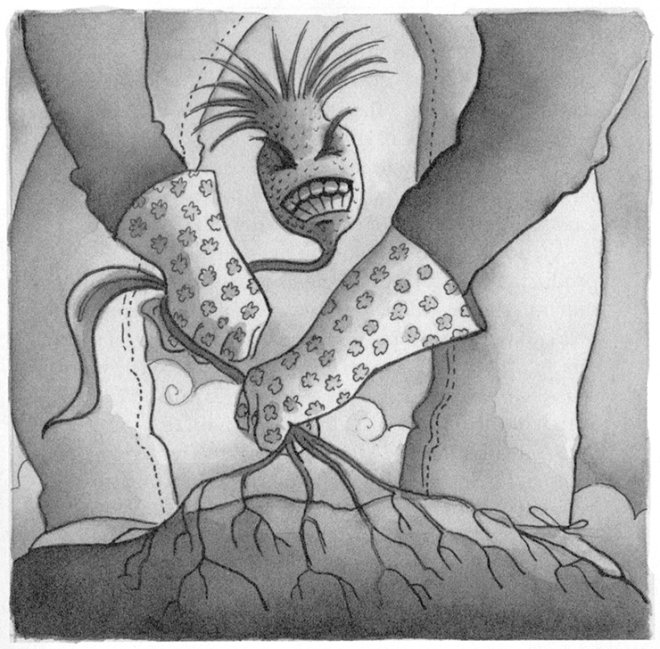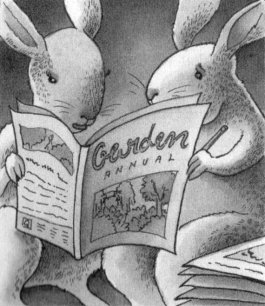Read by Pat and Becky Stone
As a volunteer master gardener for our local Cooperative Extension Service, I’m often asked, “Is this plant a weed or a flower?” Of course, the horticulturally correct answer is, “A weed is just the right plant in the wrong place.” After all, one gardener’s succulent, peppery salad green is another gardener’s rampant, invasive, strangulation machine—even though both gardeners are referring to purslane.
But let’s face it. The reason for asking if it’s a weed or a flower is simple: Do I want to invest my precious space, compost, and gardening time on this unknown visitor? And if I do, will it reward me with tender blossoms that caress the Summer breeze? Or will it laugh maniacally as it swallows petunias and small pets?
Good questions. So I’ve developed three simple rules to tell flower friend from garden foe.
- Watch the local wildlife’s reaction to the unidentified plant. It’s a well-known fact that deer and rabbits study the garden catalogs during the Winter months. They know which plants are rare and expensive. They know which plants you saved four months to purchase—the ones you snuck home from the garden center, lying to your unsuspecting spouse about the price. Yes, the animals know. And those are the plants they eat first. So if you see no signs of nibbling by the neighborhood munching machines, guess what? It’s probably a weed.
- Try pulling it out. If it’s something worth saving, you can always replant it, right? So give it a tug. Does it cling to the soil, refusing to let go? Do the roots go all the way to New Zealand (and speak with an accent)? If you do manage to rip part of it out of the ground, do five more pop up like Whack-A-Moles? If so, you are looking at a weed.
On the other hand, does it fairly faint at your touch, gasping its final breath in your hand while five nearby plants swoon in sympathy? Did your four o’ clocks get so upset by your misdeed they refused to bloom before six? Sorry, you just pulled out a flower. In fact, it was probably that rare Reconcilus Onetimius your mother-in-law gave you after you’d finally made peace with her over that little family reunion incident. Oh well, she only visits once in a while, and maybe she’ll forget. Sure.
- Perhaps by the time you noticed the stranger in your garden, it’s already flowered and is ready to produce seeds. Did it go from flower to seed in less than half an hour? Does it have 10 million tiny seeds, each with its own set of wings, wings that flap, ready to soar to the farthest reaches of the garden world? You’ve got it: There’s a reason the word weed rhymes with seed.
Or does this flower blush at the nearest thought of reproduction, producing a single, ephemeral, seed-like mite that must be stratified, scarified, rarefied, and beautified before it will even think about germination? If you plant this seed, does it take so much time to sprout that it surely must be traveling to the center of the earth and back in search of the perfect combination of light, temperature, and soil conditions? Only a plant of the highest value could put a gardener through such horticultural turmoil. You will never see another flower from this plant, but at least you’ll know it was not a weed.

If you find these basic rules to be helpful, please remember that in gardening, as in all of nature, nothing is absolute. Over the years, I’ve been blessed with many happy accidents in my garden and cursed with even more rampant disasters. My grandmother loved the black cherry tree that the birds planted in her backyard and was even happier when they sowed a mulberry tree in front. The birds in my yard spread invasive honeysuckle and thistles.

I must admit that when I see a strange plant growing where I don’t expect, my curiosity usually overrules my common sense and I leave it there to see what happens. One time I was rewarded with a lovely red Maltese cross. Another time I was overwhelmed with wild oregano.
So is it a weed or a flower? My best answer? Yes. ❖
This article was published originally in 2014, in GreenPrints Issue #99.


 Previous
Previous

